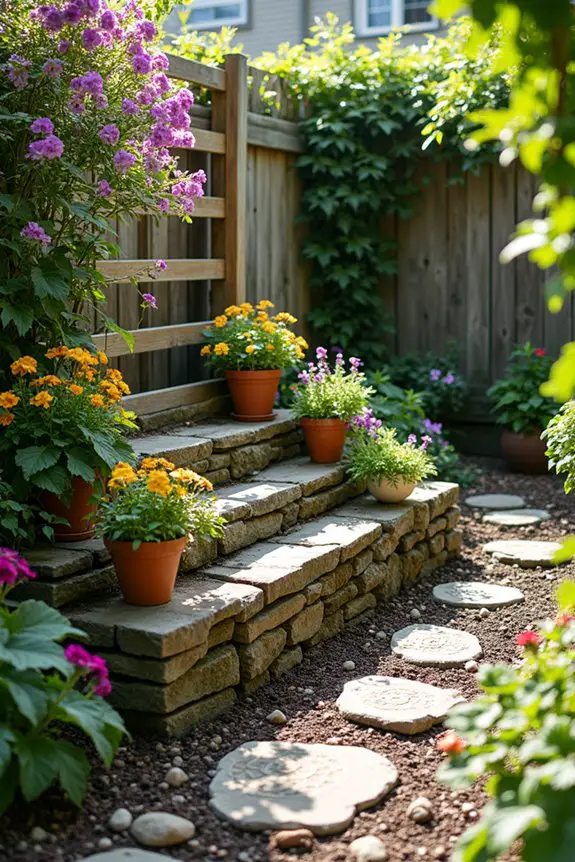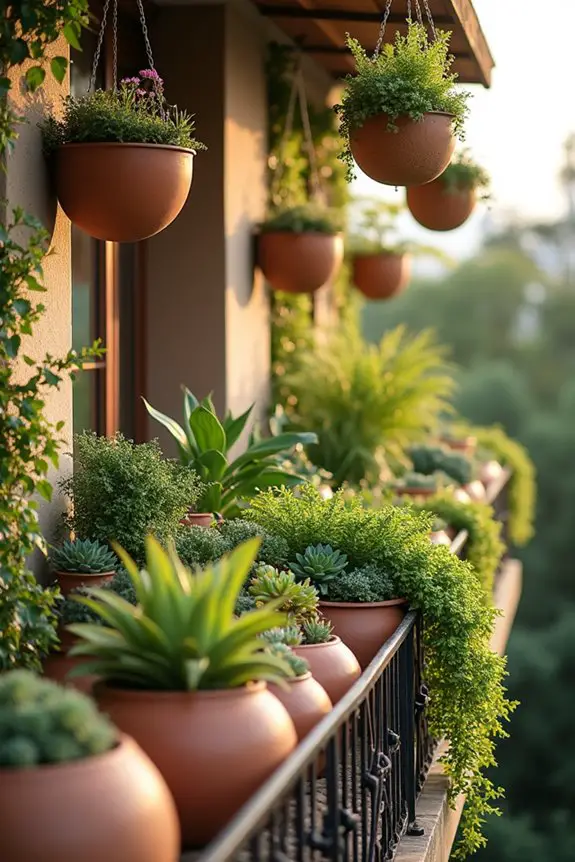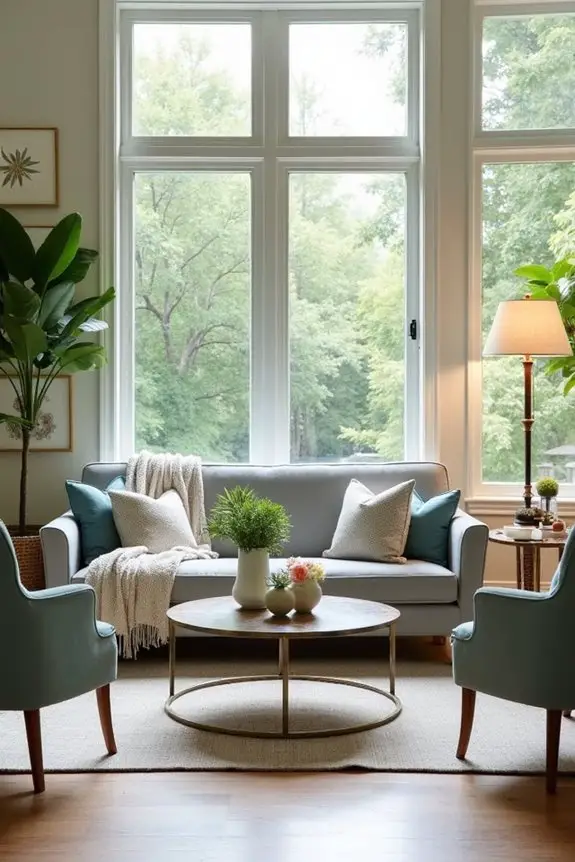Have you ever wondered if a mini garden can truly feel as grand as a sprawling park? It can! With clever design and a touch of creativity, you can transform that tiny balcony or small yard into a thriving green oasis. Picture vibrant flowers and climbing plants dancing in the breeze. Curious how to make the most of your limited space? Let’s explore some ingenious ideas that’ll inspire you to get your hands a little dirty and create a garden that’s uniquely yours.
Vertical Trellis Structures
Using vertical trellis structures can really change your mini garden game.
Imagine your climbing plants weaving their way up a colorful trellis, not only saving ground space but also stealing the show.
Plus, when you layer plants and mix them with hardscapes, you get functional zones that make your garden feel like an outdoor masterpiece—who wouldn’t want that?
1. Colorful Container Arrangement
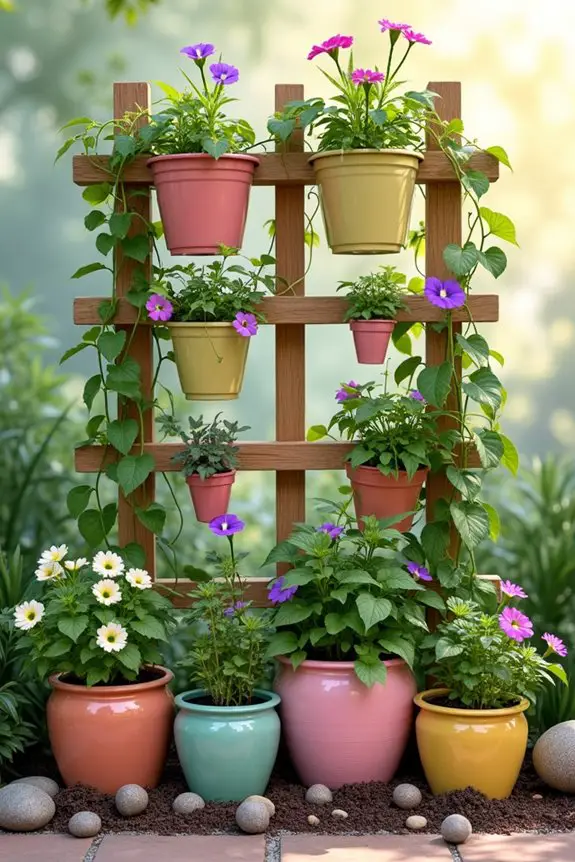
When it comes to mini garden design, colorful container arrangements combined with vertical trellis structures really hit the sweet spot. Not only do they maximize your space, but they also create a delightful visual feast, turning any cramped area into a vibrant oasis. Is there anything more satisfying than seeing your climbing plants reach for the sky, all while nestled in bright, cheerful pots that seem to dance in the sunlight?
First things first—pick a trellis. Go for something chic, maybe a simple wooden or metal frame. Not only does it provide support for your plants, but it also adds that architectural flair that makes your little garden feel more sophisticated. Fabric grow bags can also enhance this setup by providing excellent drainage and aeration for your plants.
Picture it: a beautiful climbing bean or flowering vine weaving its way up the trellis, while your containers hug the ground below like colorful friends. It’s like a garden party, and everyone’s invited.
Now, let’s talk containers. Go wild here! Use different shapes, sizes, and colors, but try to keep a theme. You don’t want it looking like a yard sale gone wrong. Maybe stick to pastel shades or vibrant hues but mix in textures. Consider terracotta, metal, or ceramic.
Group them together; it’s like a fashion runway for your plants, creating depth and dimension. Trust me, your plants will appreciate the cozy company.
Next, you’ll want to add in those climbing plants. Think about your favorites—maybe sweet peas, cucumbers, or even morning glories. Here’s where the fun starts. Plant them at the base of your trellis—if you can plant them deep enough, you’ll help them root well.
As they grow, make sure to guide them towards the trellis. It’s like coaching a star athlete; a little guidance goes a long way. Don’t worry; if they get a little tangled, just think of it as artistic flair.
Remember to water regularly, but don’t drown them; no one likes a soggy bottom. Keep an eye on both the containers and the soil around the trellis, ensuring that they get just the right amount of moisture.
To assist in regulating the moisture levels of your garden, consider using a soaker hose splitter that can help distribute water evenly to multiple plants. You might find yourself racing out with a watering can like you’re in a plant emergency, but trust me, your greenery will reward you with beauty as it flourishes.
2. Layered Plant Arrangement
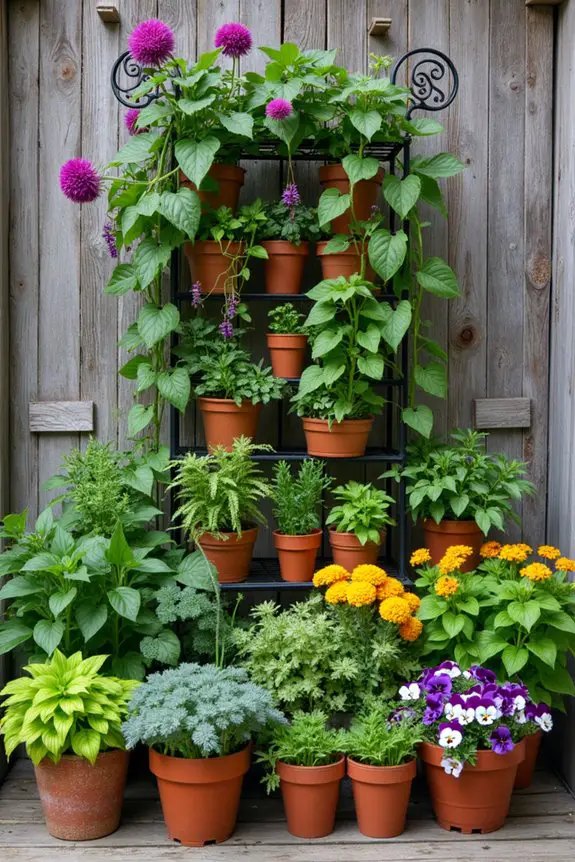
Creating a layered plant arrangement with vertical trellis structures is like choreographing a dance party in your garden—it’s lively, exciting, and oh-so-functional. By planting different heights and varieties, you not only maximize your space but also invite a dynamic vibe that keeps your visitors engaged. Imagine peeking into your mini garden, greeted by leaves of varied shapes and colors, reaching out toward the sun like they’re competing for the spotlight.
Start by selecting your trellis. Whether it’s a robust wooden one or a delicate metal frame, this will be the backbone of your layered arrangement. Think of it as the stage where all the action happens. Position the trellis against a wall or in a corner for maximum impact. Trust me, plants love a good backdrop, and you’ll enjoy the aesthetic upgrade.
Now, for the fun part—layering your plants. At the base, choose sturdy plants that can handle the crowd. Think about herbs like basil or parsley, or maybe something leafy like spinach. These can fill in the lower tier while providing fragrance and texture. Then, get ready for the show-stoppers. Add climbing plants like peas or a series of lush flowering vines that will wrap around the trellis and climb high, creating a beautiful vertical garden feast for the eyes. Additionally, a mini pop-up greenhouse can provide ideal growing conditions for your plants, especially during colder months.
And don’t forget about the middle layer! This is where you can introduce some delightful surprises. Try shorter plants that bloom or provide contrasting colors, like marigolds or pansies, to add flair between those taller climbers and the ground-dwellers. When it all comes together, you’ll have a glorious jumble of colors and textures that will make your mini garden look fuller and invite admiration.
As you arrange your layers, consider the sun and water needs of each plant. Some prefer basking in the rays of sun, while others are total introverts when it comes to light. Group them accordingly, ensuring they’re all happy campers. Remember, you can experiment with the layout; sometimes you have to try a few times to find the perfect balance. Just think of it as a trial and error garden workout. Moreover, having the right tools, such as a garden pole pruning saw, can help maintain your garden and reach those high branches as your plants grow.
Watering will be essential! Make sure you hit every level with a watering can, giving special attention to those climbing plants at the base of the trellis—they can get thirsty while reaching for the skies. With a bit of care and regular upkeep, you’ll be rewarded with a layered masterpiece that not only looks stunning but also maximizes your garden’s potential. Who knew a little creativity could lead to such a flourishing result? Happy planting!
3. Integrated Planting With Hardscapes
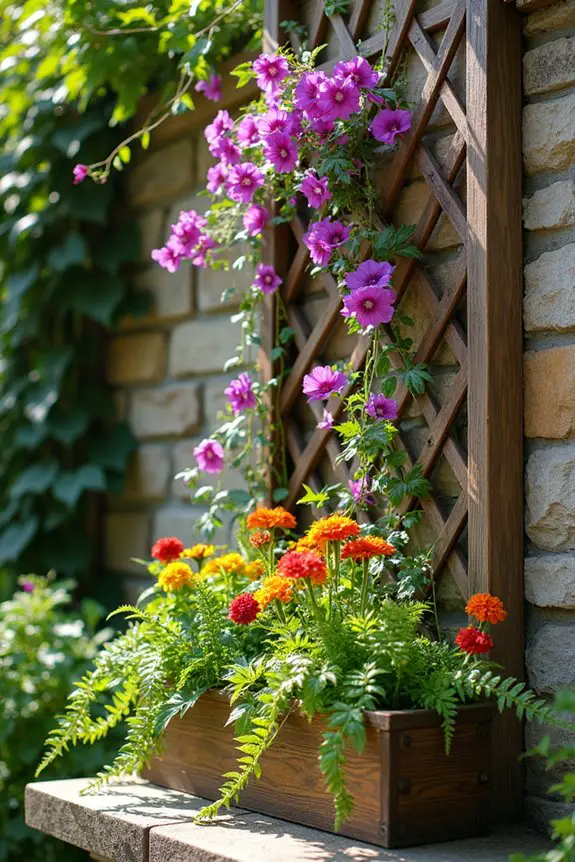
When you bring together vertical trellis structures and planting, you’re setting up a beautiful collaboration. This idea not only saves precious ground space but also adds a striking visual element to your garden. It’s like creating a living art installation right in your backyard.
To get started, think about how your hardscape can work alongside your plants. Install your trellis in a spot where it’ll get plenty of sunlight—maybe against a wall or near a patio. This placement not only makes the most of your vertical space but also creates a cozy little nook that feels inviting.
You’ll want to pair it with climbing plants like sweet peas or morning glories. They thrive on the support from the trellis, and as they climb, they’ll offer an eye-catching display.
Next, consider mixing textures and colors in your climbing ensemble. How about intertwining vibrant blooms with darker foliage? Perhaps add some herbs at the base, like fragrant basil or a zesty rosemary, to kick things up a notch. It’s practical too—having a go-to supply of fresh herbs right at your fingers while also making your garden look stunning? Winning, right?
Don’t forget to mix in some smaller companion plants around the base of the trellis. This helps to frame your vertical arrangement beautifully. Bright splashy flowers like petunias or even delicate ferns can create a lovely layered effect that draws the eye in.
Once your plants start filling in, you’ll be amazed at how alive and lush your garden becomes.
Finally, watering may seem like a minor detail, but oh, it can make or break your plants’ success. Make sure your trellis plants don’t get left in the dust when it comes to hydration. Give each section a good soak, especially those climbing guys reaching for the sun. You’re not just quenching their thirst; you’re also nurturing that perfect vibe you envisioned when you started this whole garden adventure.
In the end, integrating vertical trellis structures with your planting creates a multi-dimensional space oozing character and life. It’s functional, it’s beautiful, and it’s totally doable—even for someone who can’t keep a cactus alive. Trust me, if I can make it work, so can you.
4. Efficient Space Utilization Strategies
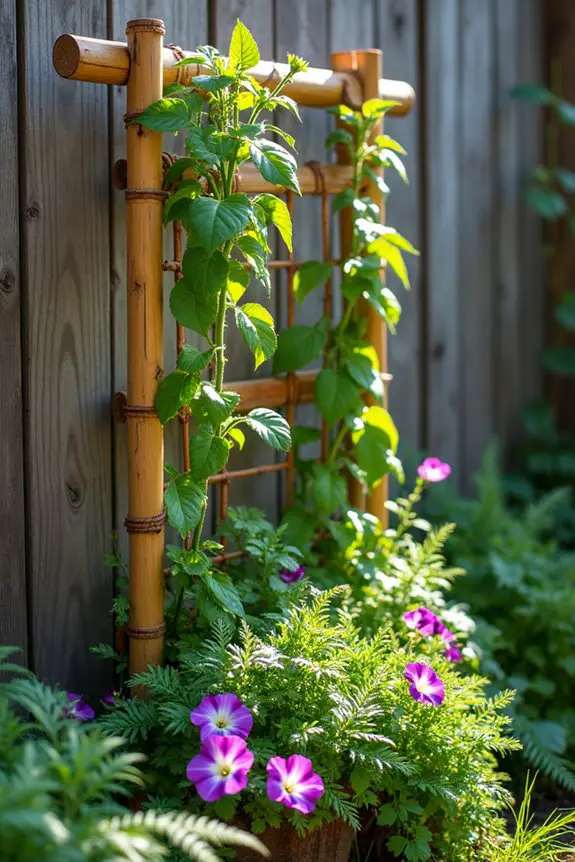
When it comes to making the most of limited garden space, vertical trellis structures are like having an extra slice of cake at a party—everyone loves it, and it definitely makes things more exciting. Not only do they allow you to grow climbing plants that stretch and twist upwards, but they also turn your garden into a vibrant, visual masterpiece. Envision a living wall adorned with colorful blooms, all while freeing up precious ground for other plants. It’s a win-win!
Let’s explore some stylish and practical strategies for using vertical trellis structures. First off, think about the types of climbing plants you want to showcase. Sweet peas, peas, or even the exuberant morning glories can transform your trellis into a colorful display. Imagine this: vibrant touches of purple, blue, or white as they spiral upward. Just picture how lively your garden will look!
Now, how do you achieve that balanced look? Mix in a little variety. Pair your vigorous climbers with some bushy herbs at the base. Basil and rosemary not only create a wonderful fragrance but also give you handy cooking ingredients right outside your door. Plus, when those climbing plants reach for the sun and add some shade, your herbs will bask in the delightful microclimate below. It’s like creating a green oasis.
And don’t overlook the importance of companion plants around your trellis. You could surround it with colorful flowers like petunias or even some delicate ferns. These little guys create a stunning base that draws the eye and adds depth to the garden. In my experience, these companion plants often steal the show, with their contrasting colors and shapes really standing out.
But here’s my favorite part—the watering routine. I’ve been known to forget the plants that cling to the trellis, leaving them parched and sad. So, be sure to soak those climbing vines below. Regular watering keeps them vibrant and lush, and trust me, you won’t want to miss that glorious moment when those blooms pop out in full color. With bamboo trellis panels, you can easily create a beautiful and functional space for these climbing plants to thrive.
5. Functional Garden Zones
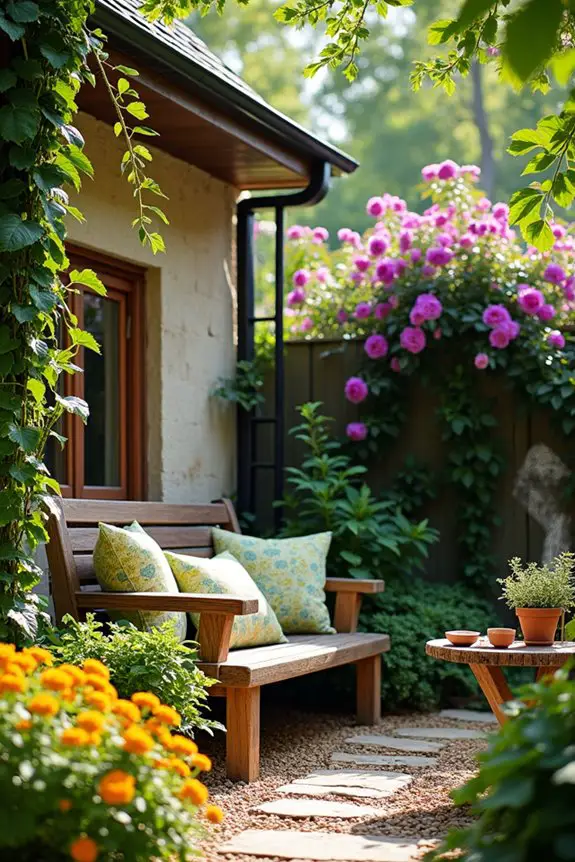
Creating functional garden zones using vertical trellis structures not only maximizes your space but also infuses a charming vibe into your outdoor space. Imagine walking through your garden and being greeted by the whimsical sights of climbing vines and colorful flowers. It transforms a simple yard into a lush, vibrant area that feels like an extension of your living room—just outdoors.
So, how do you go about crafting these functional zones? Start by selecting the right trellis. Whether it’s a sturdy wooden frame, a contemporary metal piece, or even a DIY project from an old ladder (yes, those can be surprisingly versatile), confirm it fits your garden’s style. You want it to blend in but still stand out, you know?
Next, reflect on the plants. Go for a combination of climbers and hardy base plants. For instance, pair rambling nasturtiums with robust marigolds. The nasturtiums will elegantly reach upwards, while the marigolds stay put, creating a lovely layering effect.
Which reminds me, I once planted a batch of cucumbers and forgot I put marigolds at the base. It turned into a delightful surprise when I found the marigolds boldly peeking through the vines. It made for quite the garden photo op.
And don’t forget to contemplate maintenance—your future self will thank you for this one. Regularly check the trellis plants for water. I learned the hard way that leafy climbers can often disguise their thirst. Ascertain they’re getting enough moisture by soaking the soil directly below them. Trust me, nothing feels worse than realizing you’ve been neglecting your climbing beauties during a hot day.
Lastly, create pathways and seating areas around these vertical zones. This not only makes the space functional but also invites you to linger longer. Picture yourself enjoying a cup of coffee while surrounded by climbing beans and fragrant herbs. It’s like a retreat right in your backyard.
6. Functional Garden Layouts
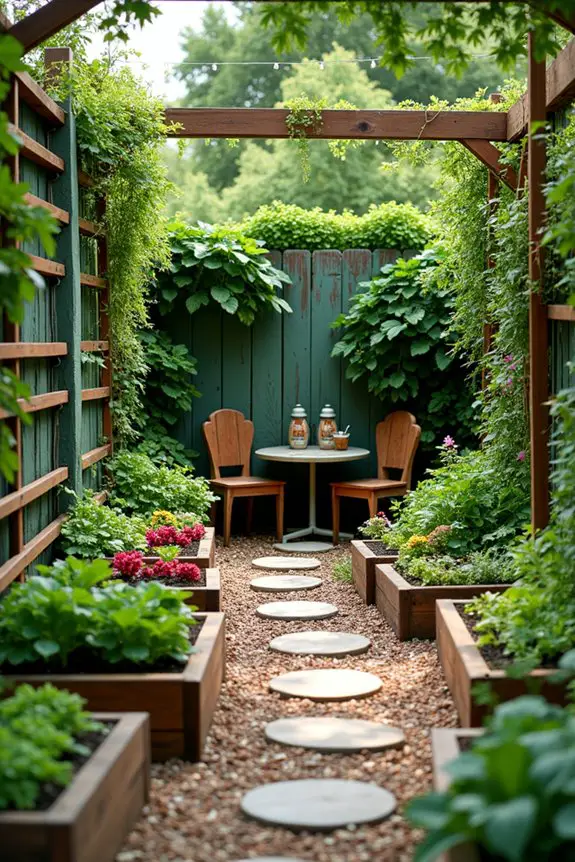
One of the most exciting ways to organize a mini garden is by embracing different functional layouts using vertical trellis structures. Not only does this approach maximize your planting area, but it also brings a sense of flow and style that can transform any outdoor space. Think of it as designing a cozy nook, but instead of just furniture, you’re using nature for your décor—how inviting does that sound?
So, how do you craft an inviting and functional garden layout? First things first, consider the flow. You want plants that crave the sun to be in the spotlight—literally. Arrange taller plants or trellises where they’ll get plenty of light while making sure shorter plants are nestled in front to create an engaging backdrop. It’s similar to putting together an outfit; you want the layers to complement each other and make a statement without clashing.
When designing your vertical zones, think about mixed elevations. Use tiered planting or raised beds to create different levels. It can feel like walking through a natural amphitheater, with each section enticing you in.
I once tried to keep my herbs and lettuces on the same level, but let me tell you, the basil was practically reaching for the heavens while the lettuce was in the shade. Talk about plant drama. Elevated beds help avoid that and also give your little seedlings more exposure without overcrowding.
And let’s not overlook practical pathways. Integrate stepping stones or mulch pathways between your planting zones. They help guide the eye around the garden while keeping muddy footprints at bay. Plus, it creates an inviting space for exploring.
Believe me, it’s a true joy to wander through with a cup of tea, whispering sweet nothings to your tomatoes while avoiding the neighbor’s curious cat. (He always seems to know when I’m busy.)
Finally, don’t skimp on enabling access to your plants. Make sure you can reach them for watering and harvesting. There’s nothing worse than losing broccoli to stubborn weeds because you made it too hard to reach.
Your future self will appreciate the thoughtful design, and so will your family—trust me.
7. Innovative Planter Arrangements
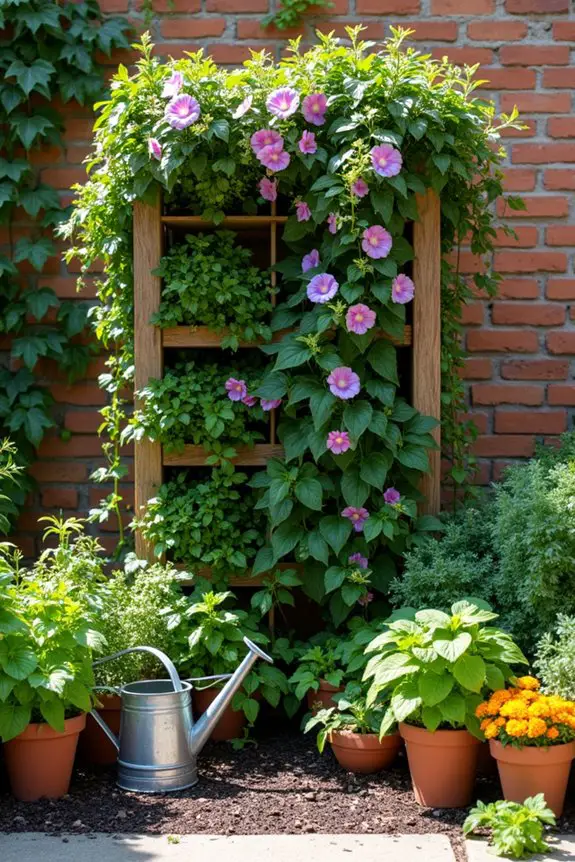
Have you ever walked through a garden and felt like you were in a cozy, green hideaway? That’s the magic of vertical planter arrangements using trellis structures. Not only do they help you maximize your planting area, but they also add a stylish flair that makes your little space feel lush and inviting.
First, let’s talk about which plants you can use with these trellises. Think about climbing varieties like peas, beans, or even beautiful flowering vines like morning glories or sweet peas. They’ll climb up, creating a wonderful green wall that draws the eye. It’s like giving your garden a hairstyle—suddenly, it looks fabulous and full of life.
Now, when you set up your trellis, place it in a spot where your climbing plants can get a good dose of sunlight. Don’t forget—you want your taller plants in the back, cascading down into the shorter ones in front. Imagine playing Tetris with your plants, fitting them perfectly for the most ideal display.
For a playful twist, why not try an “A-frame” structure? It creates levels, allowing you to grow multiple types of plants at different heights. Picture it—a cascade of vibrant colors and textures. You’ll feel like a garden artist, and who doesn’t want to be creative in the great outdoors?
Another fun tip? Mix your foliage! Use contrasting leaf shapes and colors when selecting your climbing plants. Pairing a feathery vine with a thick, hearty one adds depth and intrigue. It’s like putting together a colorful salad that’s not just nutritious but pleasing to the eyes too. Remember, a little diversity goes a long way in keeping your vertical garden visually interesting and fresh.
Finally, make sure to incorporate some practical elements, like accessible watering spots. A garden that looks great is important, but a garden you can easily maintain? Now that’s a win-win.
I once had a trellis that got so overgrown, I could barely see my delicious cucumbers behind the leafy chaos. Talk about a garden hide-and-seek gone wrong. By keeping pathways clear and accessible, you can enjoy both the beauty and the bounty of your vertical garden.
8. Architectural Garden Features
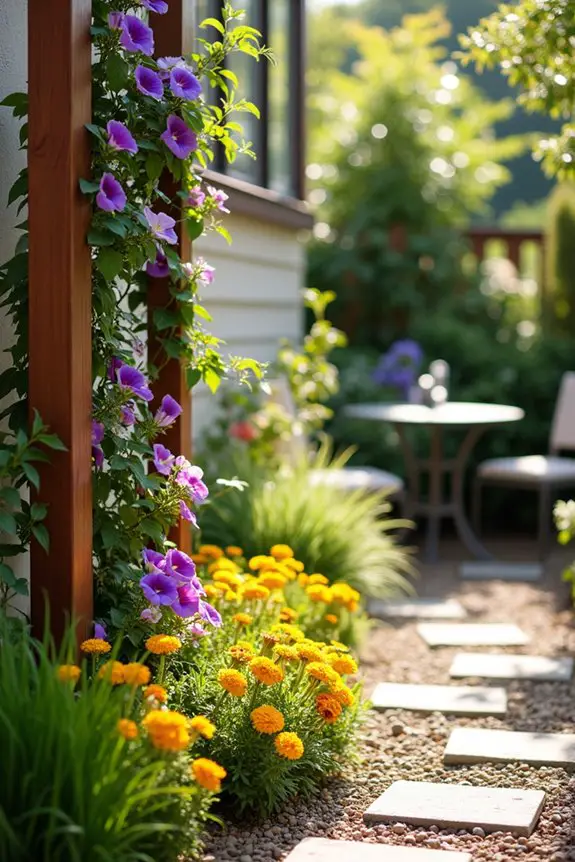
When it comes to enhancing your garden’s charm, architectural features like vertical trellis structures are game-changers. Not only do they serve a practical purpose by supporting climbing plants, but they also add a sophisticated visual element that makes your garden feel like a stylish retreat. Think of them as the bones of your outdoor oasis, giving structure to all the beautiful growth that flourishes in your space.
Let’s explore how to make the most of these trellises. First up, consider the materials. Wood, metal, or even upcycled materials can create that unique vibe you’re after.
Wood adds warmth, while metal might evoke a more modern feel. Choose something that speaks to your personal style because your garden should reflect you, right?
Next, think about placement. You don’t want your trellis to just be plopped down randomly. Position it where it can catch the most sunlight while serving as a lovely backdrop for your smaller plants in front. It’s like framing a painting—once you get it right, everything pops.
Now let’s talk plants! Vining plants are your best friends here. Imagine elegant morning glories or cheerful sweet peas scaling up your trellis for that much-desired greenery and color.
Picture it—a little green wall bursting with life, what a sight! And, for a touch of fun, sprinkle in some compact flowering plants at the base to create a striking contrast. It’s like a garden pep rally, with everyone cheering for the beautiful display.
In terms of maintenance, don’t forget accessibility. No one wants to play hide-and-seek among the vines just to pick a few tomatoes.
Having a clear path around your trellis means you can easily reach your bounty while still enjoying the lushness. Trust me, I once lost a whole batch of cherry tomatoes behind a wall of leaves, and let me tell you, that was sheer agony.
Lastly, a well-designed trellis doesn’t just scream functionality; it’s an artistic statement, a delightful invitation to step into your personal greenery haven.
9. Biophilic Design Principles
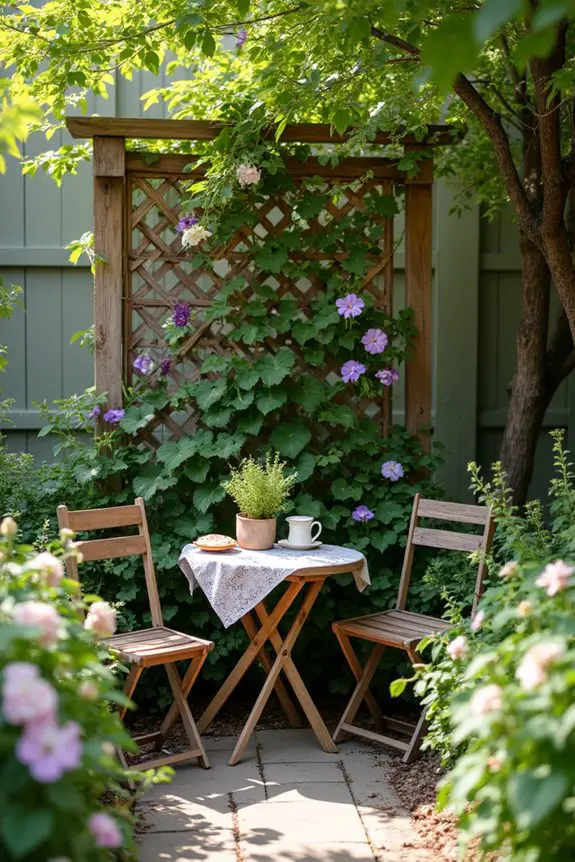
When it comes to maximizing your garden space while keeping it stylish, let’s talk about vertical trellises. They’re not just about making your plants happy; they create a stunning backdrop that elevates the whole atmosphere of your garden. Imagine lush greenery climbing higher, filling the air with life and color—it’s like your garden just put on a fancy outfit for a special occasion.
One of the best things about using a vertical garden design with trellises is the way they fit into smaller spaces. Instead of sprawling out horizontally, your plants get to reach for the sky. It makes your garden feel more open and airy, as if it’s bursting with possibility. Plus, let’s be honest, who wouldn’t want a cozy place to sip tea while surrounded by a mini jungle?
So, how do you get started? First, pick a spot that gets a good amount of sun, but isn’t too crowded. This way, your trellis can shine and your plants can stretch out their tendrils without getting tangled in too much chaos (trust me, untangling a tomato plant can feel like a bad hair day).
Next, select your climbing plants wisely. Think sweet peas or morning glories—they have strong climbs and the blooms will pop against your trellis, as if they’re showing off at a fashion show. And for the base, a lovely layer of compact flowering plants can create a sweet little frame that makes everything stand out even more, kind of like the perfect footwear for your outfit.
Be sure to maintain accessibility as you design your mini paradise. You don’t want to be doing an acrobatic dance just to grab your fresh veggies. A clear path around your trellis can save you from hunting down those precious tomatoes, which honestly can feel like finding lost socks in the laundry—frustrating!
Lastly, don’t forget that your trellis isn’t just functional; it’s a piece of art. Let your personality shine through in the materials you choose and the colors you plant.
A trellis can be your garden’s crown, adding charm and inviting folks to come and take a closer look. So go ahead, embrace the vertical, and watch your garden transform into a lively space where everyone will want to gather.
10. Terraced Planting Techniques
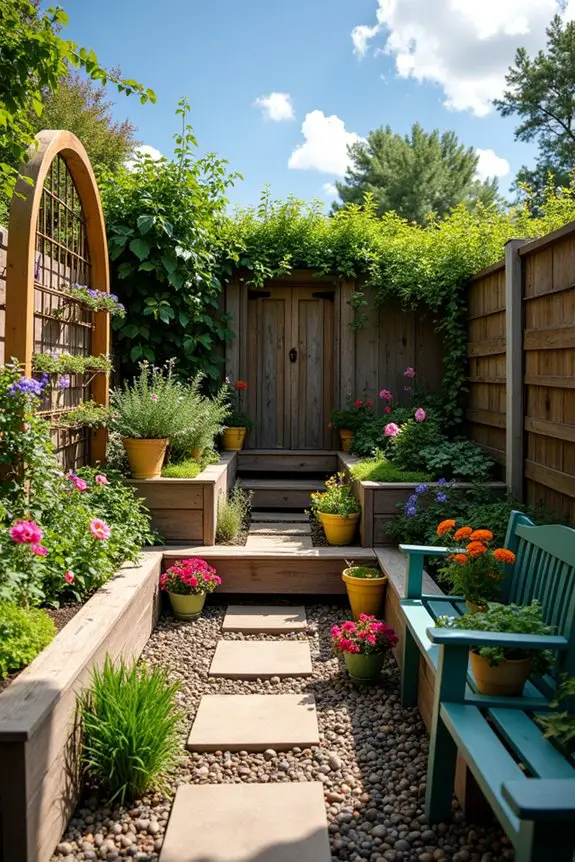
Let’s explore the world of terraced planting techniques with vertical trellis structures. This idea works wonders in smaller gardens or yards, giving you that spacious, airy vibe while maximizing every square inch. And let’s face it, nothing says “impressive garden” quite like a whimsical jungly feel that also happens to be super functional.
First off, envision transforming that flat space into a multi-tiered wonderland. You can build layers using retaining walls or even simple cardboard boxes (hey, no judgment here). Imagine this: a sturdy trellis stands tall, while at its base sits a delightful array of compact flowering plants, like petunias or succulents. It’s like levels in a video game, but way more peaceful—and unless you’re a garden ninja, you won’t need any special skills.
Now, let’s talk about how to make this truly sing in your space. Begin by choosing a corner or wall that deserves the spotlight. You want it to be where you can truly appreciate it every time you step outside.
Then, decide on your climbing plants. Try sweet peas for their stunning blooms or English ivy if you’re going for that classic, elegant look. Not only will they climb, but they’ll also create a beautiful tapestry in the air—like a botanical version of a cozy quilt.
Accessibility is key! You can invest in some stepping stones or create a simple path between your tiers. That way, you can grab those fresh veggies without having to perform any acrobatics. Trust me, no one wants to be caught doing the awkward dance of trying to reach a ripe tomato only to lose their balance and plummet into a billow of marigolds.
Lastly, don’t forget to sprinkle in personality. Whether it’s bright pots, unique trellis designs, or themed plants, make it fun. Your garden should reflect who you are—quirky, elegant, or somewhere in between. Remember, this is your special space, so deck it out!
Now go ahead and embrace your inner garden designer. With terraced planting and vertical structures, you’re not just growing plants; you’re creating a mini paradise that’s absolutely “you.”
Space-efficient Plant Pairing
While you might think that pairing plants in a small garden can be a challenging task, it turns out you can create a vibrant little oasis with a bit of strategy.
Start by choosing compact plants that can grow well together—like basil and tomatoes. They not only enjoy each other’s company but also save space in your mini garden ideas for small spaces.
Choosing compact companions like basil and tomatoes not only maximizes space but also creates a harmonious mini garden.
Layer different heights, too. Think trailing plants in containers alongside upright flowers. It’s like a dance party for your garden! You’ll get depth and interest without crowding.
And if you’re unsure, try mixing textures; it adds richness without overwhelming your tiny patch. Don’t worry—your plants won’t judge you for a little trial and error.

